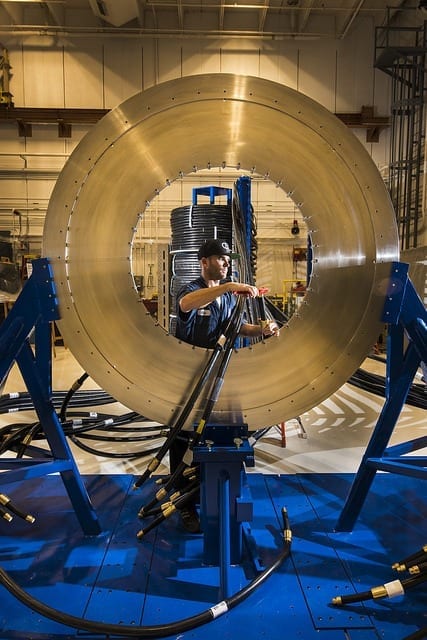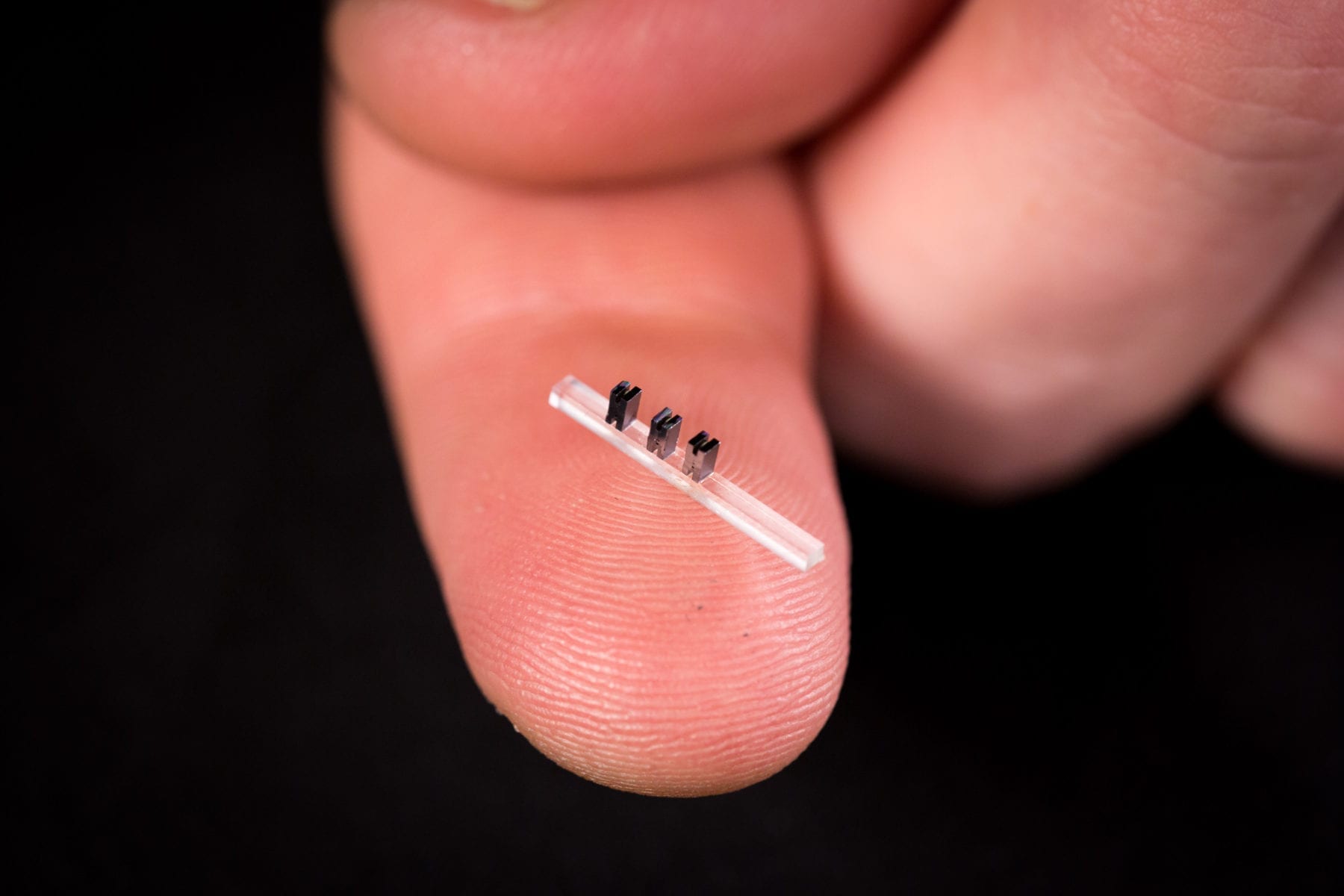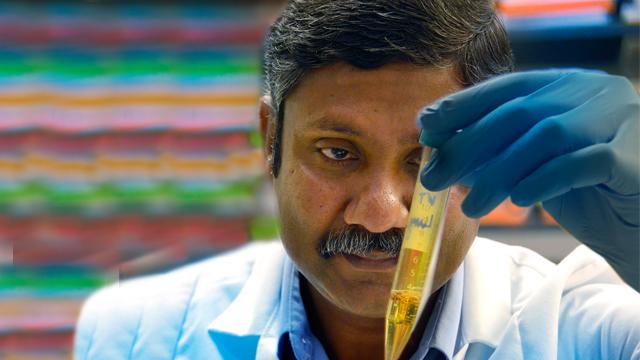
A new Sandia National Laboratories accelerator called Thor is expected to be 40 times more efficient than Sandia’s Z machine, the world’s largest and most powerful pulsed-power accelerator, in generating pressures to study materials under extreme conditions.
“Thor’s magnetic field will reach about one million atmospheres, about the pressures at Earth’s core,” said David Reisman, lead theoretical physicist of the project.
Though unable to match Z’s 5 million atmospheres, the completed Thor will be smaller — 2,000 rather than 10,000 square feet — and will be considerably more efficient due to design improvements that use hundreds of small capacitors instead of Z’s few large ones.
Remarkable structural transformation
This change resembles the transformation of computer architecture in which a single extremely powerful computer chip was replaced with many relatively simple chips working in unison, or to the evolution from several high-voltage vacuum tubes to computers powered by a much larger number of low-voltage solid-state switches.
A major benefit in efficiency is that while Z’s elephant-sized capacitors require large switches to shorten the machine’s electrical pulse from a microsecond to 100 nanoseconds, with its attendant greater impact, the small switches that service Thor’s capacitors discharge current in a 100-nanosecond pulse immediately, obviating energy losses inevitable when compressing a long pulse.
The new architecture also allows finer control of the pulse sent to probe materials.
Toward a more perfect pulse shape
Said Reisman, “Individual cables from pairs of capacitors separate our signals. By combining these signals in any manner we choose, we can tailor very precise pulses of electrical current.”
Tailored pulse shapes are needed to avoid shocks that would force materials being investigated to change state. “We want the material to stay in its solid state as we pass it through increasing pressures,” he said. “If we shock the material, it becomes a hot liquid and doesn’t give us information.”
Another advantage for Thor in such testing is that each capacitor’s transit time can be not only controlled to the nanosecond level but isolated from the other capacitors. “In 30 seconds on a computer, we can determine the shape of the pulse that will produce a desired compression curve, whereas it takes days to determine how to create the ideal pulse shape for a Z experiment,” Reisman said.
Furthermore, because Thor can fire so frequently — less hardware damage per shot requires fewer technicians and enables more rapid rebooting — researchers will have many more opportunities to test an idea, he said.
But there’s more at stake than extra experiments or even new diagnostics. There’s testing the efficiency of a radically different accelerator design.
Radical shoeboxes
Thor’s shoebox-sized units, known as “bricks,” contain two capacitors and a switch. The assembled unit is a fourth-generation descendant of a device jointly developed by Sandia and the Institute of High-Current Electronics in Tomsk, Russia, called a linear transformer driver (LTD). The original LTD units, also called “bricks,” had no cables to separate outputs, but instead were linked together to add voltage as well as current. (Because Thor’s bricks are isolated from each other, they add current but not voltage.)
Everything depends upon adding bricks. Sandia is building Thor in stages and already has assembled materials. Two intermediate stages are expected in 2016. These will comprise 24 bricks (Thor 24) and 48 bricks (Thor 48). “These are ‘first-light’ machines that will be used for initial experiments and validation,” Reisman said.
Thor 144, when completed, should reach 1 million atmospheres of pressure.
Read more: Thor’s hammer to crush materials at 1 million atmospheres
The Latest on: Pulsed-power accelerator
[google_news title=”” keyword=”pulsed-power accelerator” num_posts=”10″ blurb_length=”0″ show_thumb=”left”]
via Google News
The Latest on: Pulsed-power accelerator
- Laser-driven particle accelerationon April 25, 2024 at 3:56 am
The acceleration of charged particles to ultra ... When the intensity of the laser pulse is increased, the ponderomotive force becomes large enough to expel all the electrons, forming an ion ...
- Porsche’s new all-electric Macan is much more Taycan than Macanon April 23, 2024 at 5:00 am
When using a 400-volt fast charger, which is more common in Ontario, the Macan EV can charge at a rate of up to 135 kilowatts. With an 800-volt charger that number jumps up to 270, which means 10 to ...
- Electro-optic 3D snapshot of a laser wakefield accelerated kilo-ampere electron bunchon April 8, 2024 at 5:00 pm
harnesses the power of high-intensity laser pulses to drive plasma waves with acceleration gradients orders of magnitude higher than conventional RF-based accelerators. Treating the laser pulse as ...
- Focusing ultra-intense lasers to a single wavelengthon April 1, 2024 at 5:00 pm
They help researchers delve into strong-field laser physics, laser-driven radiation sources, particle acceleration, and more. "Peak power" measures the intensity of these lasers, like the Nova ...
- World’s most powerful laser ushers dawn of new era in health, spaceon April 1, 2024 at 5:05 am
referred to as BELLA (Berkeley Lab Laser Accelerator). By concentrating all of its energy into a pulse lasting about thirty femtoseconds, BELLA was the first laser to produce a petawatt of power ...
- Rocketstar Aneutronic Fusion-enhanced Electric Pulsed Plasma Propulsion Will Be Tested in Orbiton March 23, 2024 at 10:12 am
RocketStar, a US based startup, has successfully demonstrated an electric propulsion unit for spacecraft that uses nuclear fusion-enhanced pulsed plasma. During ground tests the process did create ...
- Scientists make a laser accelerator with 10 billion electron-volt beamon November 30, 2023 at 2:49 am
This accelerator operates ... hour for the experiment. A single pulse emitted by a petawatt laser contains roughly 1,000 times the installed electrical power in the US, lasting only 150 ...
- 2008 Pulse Motorhome Prices and Specson March 27, 2023 at 11:03 am
A diesel-powered Class C motorhome brand created by Fleetwood RV, Pulse products were built on the Dodge Sprinter van. 25-foot recreational vehicles, Pulse motorhomes have interiors designed to ...
- About the Zebra Pulsed Power Labon August 16, 2020 at 11:20 pm
The Zebra Pulsed Power Lab is housed in the SAGE building ... on scaled-down versions of the largest research facilities in the country, such as the Z-Accelerator at Sandia National Laboratory and the ...
- How to Control a Stepper Motor Using a Computeron July 18, 2018 at 6:32 am
A stepper motor requires more electrical power than that provided ... you program an acceleration by producing a much lower pulse rate initially, then gradually increase the rate until it reaches ...
via Bing News










